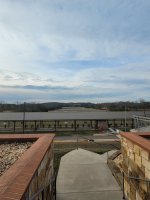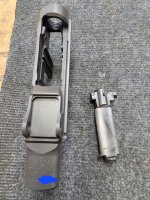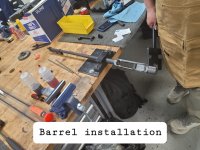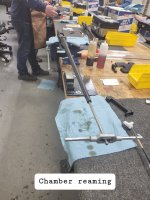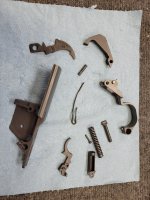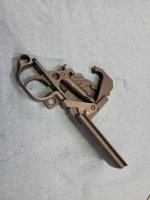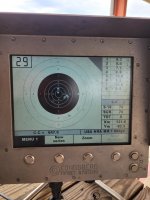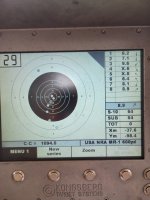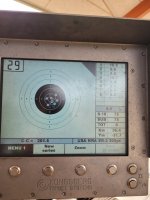I recently was able to attend the CMP M1 AMC (Advanced Maintenance Course) in Anniston Alabama, I thought some of you may would like to hear about the experience.
In my understanding this course has not been held for about 4 years. CMP held a lottery for a class seat. I was initially on a waiting list, but was selected a couple weeks prior to the 1st class for 2024. This course is facilitated by the CMP Custom Shop. There were 40 seats for the course, all were full, and they claimed the rest of the classes are already filled for 2024. There aren't any CMP affiliated clubs in my general area so joining the Garand Collectors Association got me the bona fides I believe my DD214 might have worked as well. https://thegca.org/
All the parts used were refinished, new, NOS, reproduction, or original and in excellent condition. As we went through each part we were schooled on what to look for and why. Production changes and methods of manufacture were noted in the specific parts, possibly with some reasoning that drove the change, be it cost, speed or remedy for failures. The completed rifles are "Expert" grade. The cost of the rifle is $1150, which is what you can by them directly from CMP. The course fee was $1200. Total $2350. I joked that I built the same thing that CMP sells, and they charged me $1200 to do it for them.
Food and lodging not included. Coffee and donuts , water and Coke were supplied.
Day 1 started with receiver selection. We were fortunate in that the cadre had cherry picked the receivers and bolts. All receivers were Springfield Armory, while the bolts were of mixed manufacture. The serial number range was varied. Some where lead dipped annealed on the tail of the receiver.
I selected a 6 digit receiver, which an internet search dates as made in 1942. We took time to lap the bolt lugs and receivers, followed with the installation of new short chambered Criterion barrels. We used rods on the front sight base and one through the rear sight ears to visually align the sighting plane. Final step of the day was to finish ream the chambers by hand using a reamer with a bushing on the rear that made controlling the depth easy. Headspace was verified on each.
A break in the day allowed a tour of the warehouse and CMP Custom Shop. No photos were allowed. We did see crates of various rifles to include incoming and out going Garands, 1917 Enfields, 1903's, and they even still have some Krags to be processed through. The Custom Shop is pretty modestly equipped, but the cadre seem very knowledgeable and enjoy what they do. A gorgeous tiger striped 1903 stock was being fitted for a customer build. Various other projects were in process. The 1911 space was in a separate area, and strictly off limits.
The second day started at the CMP Store in Anniston. The selection was varied in makes models, and conditions. A shit load of money was spent by the course attendees. A rack grade 1903 followed me home along with my yearly allotment of 400rds of surplus Lake City 30.06.
Day 2 continued with the feed mechanism, trigger assembly, and sight installation. For each assembly, we were shown a method or trick if you will to make it all go together easily. When it came to the op rod everyone had the chance to rifle through a box and try different ones utilizing a "tilt test" until one slid smoothly open and shut. Several needed just a touch to get them moving. I must have tried half a dozen before getting one that slid freely.
Final installation was into a new Minelli Walnut stock.
The third day was at the CMP Talladega Shooting Complex. If you've never been, its worth the trip. Like shooting on a golf course.
After a safety briefing you were issued a "Safety Card" good for 1 year.
Each rifle was test fired and sighted in at 100 yards by the staff to test function. Of note, they bottom out the rear sight and come up 10 clicks to start with. Every rifle was on "paper". Each firing line utilizes Kongsberg electronic target system. If a rifle had an issues it was dealt with and corrected with the help of the Custom Shop staff. Only a few had issues, I think all were handled on the line through a part swap or a tweak here or there.
We were given 16 more rounds and a pass for the remainder of the day. After proving you could put 3 consecutive rounds in 1.5" your card was punched to show you could go to the 200,300 and 600 yard range. Another stop at the on sight store for more ammo was in order. Creedmoor match ammo was available in 50rd boxes made up of Lapua brass, loaded with 167gr Scenars and tailored for the M1. Cost was about $100/box. The brass alone retails over $1.50 so I don't see them making much money off this. Firing at 200 and printing in the black allowed you to proceed to 300 and then 600.
Although pleased with my 300 yard performance, these 52y/o eyes don't work so great with irons at 600, but they were all on the target so I'll not complain too much. We did not have the option to install NM sights not that it would have made a huge difference for me.
A nice blow molded CMP case to ship or take the Garand home was provided, along with a rifle certificate, manual, and a copy of "The US .30 Caliber Gas Operated Service Rifles: A Shop Manual, Volumes I&II", oh, and one En bloc clip.

In my understanding this course has not been held for about 4 years. CMP held a lottery for a class seat. I was initially on a waiting list, but was selected a couple weeks prior to the 1st class for 2024. This course is facilitated by the CMP Custom Shop. There were 40 seats for the course, all were full, and they claimed the rest of the classes are already filled for 2024. There aren't any CMP affiliated clubs in my general area so joining the Garand Collectors Association got me the bona fides I believe my DD214 might have worked as well. https://thegca.org/
All the parts used were refinished, new, NOS, reproduction, or original and in excellent condition. As we went through each part we were schooled on what to look for and why. Production changes and methods of manufacture were noted in the specific parts, possibly with some reasoning that drove the change, be it cost, speed or remedy for failures. The completed rifles are "Expert" grade. The cost of the rifle is $1150, which is what you can by them directly from CMP. The course fee was $1200. Total $2350. I joked that I built the same thing that CMP sells, and they charged me $1200 to do it for them.
Food and lodging not included. Coffee and donuts , water and Coke were supplied.
Day 1 started with receiver selection. We were fortunate in that the cadre had cherry picked the receivers and bolts. All receivers were Springfield Armory, while the bolts were of mixed manufacture. The serial number range was varied. Some where lead dipped annealed on the tail of the receiver.
I selected a 6 digit receiver, which an internet search dates as made in 1942. We took time to lap the bolt lugs and receivers, followed with the installation of new short chambered Criterion barrels. We used rods on the front sight base and one through the rear sight ears to visually align the sighting plane. Final step of the day was to finish ream the chambers by hand using a reamer with a bushing on the rear that made controlling the depth easy. Headspace was verified on each.
A break in the day allowed a tour of the warehouse and CMP Custom Shop. No photos were allowed. We did see crates of various rifles to include incoming and out going Garands, 1917 Enfields, 1903's, and they even still have some Krags to be processed through. The Custom Shop is pretty modestly equipped, but the cadre seem very knowledgeable and enjoy what they do. A gorgeous tiger striped 1903 stock was being fitted for a customer build. Various other projects were in process. The 1911 space was in a separate area, and strictly off limits.
The second day started at the CMP Store in Anniston. The selection was varied in makes models, and conditions. A shit load of money was spent by the course attendees. A rack grade 1903 followed me home along with my yearly allotment of 400rds of surplus Lake City 30.06.
Day 2 continued with the feed mechanism, trigger assembly, and sight installation. For each assembly, we were shown a method or trick if you will to make it all go together easily. When it came to the op rod everyone had the chance to rifle through a box and try different ones utilizing a "tilt test" until one slid smoothly open and shut. Several needed just a touch to get them moving. I must have tried half a dozen before getting one that slid freely.
Final installation was into a new Minelli Walnut stock.
The third day was at the CMP Talladega Shooting Complex. If you've never been, its worth the trip. Like shooting on a golf course.
After a safety briefing you were issued a "Safety Card" good for 1 year.
Each rifle was test fired and sighted in at 100 yards by the staff to test function. Of note, they bottom out the rear sight and come up 10 clicks to start with. Every rifle was on "paper". Each firing line utilizes Kongsberg electronic target system. If a rifle had an issues it was dealt with and corrected with the help of the Custom Shop staff. Only a few had issues, I think all were handled on the line through a part swap or a tweak here or there.
We were given 16 more rounds and a pass for the remainder of the day. After proving you could put 3 consecutive rounds in 1.5" your card was punched to show you could go to the 200,300 and 600 yard range. Another stop at the on sight store for more ammo was in order. Creedmoor match ammo was available in 50rd boxes made up of Lapua brass, loaded with 167gr Scenars and tailored for the M1. Cost was about $100/box. The brass alone retails over $1.50 so I don't see them making much money off this. Firing at 200 and printing in the black allowed you to proceed to 300 and then 600.
Although pleased with my 300 yard performance, these 52y/o eyes don't work so great with irons at 600, but they were all on the target so I'll not complain too much. We did not have the option to install NM sights not that it would have made a huge difference for me.
A nice blow molded CMP case to ship or take the Garand home was provided, along with a rifle certificate, manual, and a copy of "The US .30 Caliber Gas Operated Service Rifles: A Shop Manual, Volumes I&II", oh, and one En bloc clip.
Last edited:

